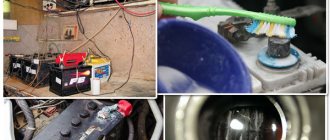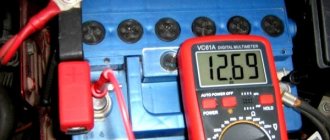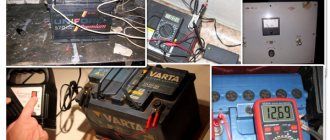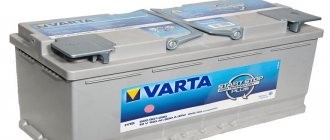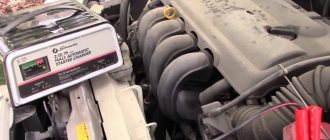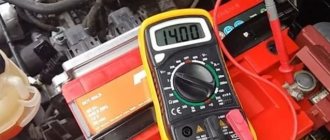As soon as it gets cold outside, most car owners encounter a problem when the battery is discharged, and therefore the car starter does not turn over. This phenomenon causes a number of inconveniences, because the vehicle may refuse to start at the most awkward moment. In order to avoid such a situation, it is necessary to prepare the battery for winter and the onset of cold weather.
The reason for this problem lies in the fact that in winter the battery starts the engine with thick oil, and accordingly the load placed on the battery increases sharply. Charging the battery begins from the moment it warms up, that is, while driving.
To prepare your battery for winter you need to go through 2 simple steps :
- Charging the battery using a charger and restoring the density of the electrolyte.
- Insulation of the battery using insulation and special devices.
At the end of the article you will find detailed video instructions that will clearly show how to apply all the knowledge gained from the article in practice.
Why does my battery drain faster in winter?
Before you understand how to prepare a vehicle battery for cold weather, you need to understand the reasons for the difficulties that arise. In winter, the battery operates in extreme mode due to the following factors:
- High energy consumption for heating the interior, windows and mirrors.
- Short trips that do not allow the battery to fully charge.
- Frequent starting of the starter , which occurs due to the difficulty of starting a cold engine.
The last reason is less significant, since this problem can be solved when the battery is fully charged and produces the required current in accordance with the required parameters. Experienced car enthusiasts also advise using a little trick - before starting the engine, you can turn on the headlights, leaving them on for a couple of minutes, which will allow the battery to warm up.
It is physically impossible to solve the second problem, since traveling short distances is a fact that must be put up with. To mitigate the importance of the first reason, you need to refrain from turning on additional equipment. If it’s cold in the car, then you need to wait a little, refusing to heat the interior, at least for the first 5-10 minutes from the moment you start driving.
Removing the battery from a car in cold weather
During the cold season, the battery charges much less well, which can affect engine starting. The solution to the problem depends on the life of the battery: new ones fail extremely rarely, so it will be enough to “warm up” the battery by turning on the headlights for a couple of minutes, after which you can start the engine. With old batteries, everything is much more complicated, because they need to be removed and moved to a warm place for charging and cleaning.
Even a beginner in this matter can remove the battery from a car, the main thing is to follow the instructions:
- Open the hood of the vehicle.
- Remove the “insulation” - this point is not for everyone, since it is not always present.
- Disconnect the "negative" terminal.
- Remove the positive terminal.
- Remove the battery mount.
- Remove the battery.
- Check the ventilation openings and their cleanliness; if there is dirt, it must be removed.
- Remove dirt from the battery case using a solution - 1-2 teaspoons of soda per glass of water. The importance of this procedure is difficult to overestimate, since dirt can cause self-discharge of the device.
When removing the terminals, you need to make sure the order is correct. If you initially disconnect the “positive” terminal, this may lead to a short circuit and damage to the entire electronics of the car. It is also necessary to remember that under no circumstances should the battery be tilted or knocked on it .
Charging your battery while preparing for winter
The first and most important step in preparing a battery for the winter is charging it. First of all, you need to remove the battery from the vehicle, and then thoroughly clean it to remove all types of contaminants. The next step is to clean the terminals with sandpaper, which improves contact (current conductivity).
Before charging a car battery, it is necessary to unscrew the plugs from the filler holes (cans), which will give access to the electrolyte and check its level. Optimally, it should cover the plates by 1-1.5 centimeters. If this condition is not met, you need to take distilled water and add it to all holes.
The next step is charging the battery. To simplify this process as much as possible, it is advisable to purchase a popular charger (charger), which allows you to minimize the amount of work performed. During this you need to follow some rules:
- It is necessary that the plugs remain unscrewed (open filler necks).
- When connecting the charger to the battery, it is important to observe the polarity: the black wire is the negative terminal, the red wire is the positive terminal. An error in polarity can damage the charger, with the exception of devices that have special protection.
- Once you have connected the charger to the battery, you can plug it into the power supply.
- Expensive chargers prevent the electrolyte from boiling strongly during charging; however, it is recommended to carry out the battery charging procedure in a ventilated, and preferably non-residential, area (for example, a loggia or garage, or, in extreme cases, a corridor).
- Leave the battery to charge; this procedure takes from 10 to 13 hours.
- You can verify that charging is complete by checking the gas bubbles released from the electrolyte.
Once the battery is fully charged, it must be unplugged and left for a couple of hours to settle.
Procedure for recharging the battery
Let's look at the procedure for recharging a “dry” battery. Everything is quite simple: fill in the electrolyte. The only condition is that the temperature of both the electrolyte and the battery being filled must be at least 10 degrees Celsius. All plugs on the battery must be open. We fill each jar either to the special mark or to a level above 1.5 cm above the plate. After this, let the battery sit for 15–20 minutes, rock it slightly from side to side and, if necessary, add electrolyte. Then we tighten the plugs tightly - the battery is completely ready for use. Naturally, already filled batteries do not need such a procedure.
Now let's look at how to properly store a battery in Russian winter conditions. Some domestic car enthusiasts (and there are many of them) prefer not to use their car in winter. This is mainly afforded by those who have the opportunity to keep a car not in the open air, but at least in an unheated garage. If you are one of this group of car owners, then the minimum that needs to be done to preserve the battery is to disconnect one of the battery terminals. And ideally, completely remove the battery and take it home, where it will winter well in a warm room. This applies when the garage is not heated. If the car will spend the winter in a warm room, then such measures should not be taken.
How to increase the electrolyte density in a battery in winter and summer
Now you can start checking the density of the electrolyte; a special device, a hydrometer, will help you take measurements. The electrolyte is an aqueous solution of sulfuric acid, so you need to be careful and carry out all procedures using special rubber gloves .
The density of the electrolyte is based on the ratio of distilled water and sulfuric acid - 1 to 1.25, respectively. Therefore, the normal density of the electrolyte is 1.25-1.27 g/cubic meter. cm at temperatures from +18 to +25 degrees Celsius, and in order for it not to freeze in winter, the density must be at least 1.18 g/cu. cm.
You can increase the density of the electrolyte by draining the old aqueous solution of sulfuric acid from the battery, replacing it with a new ready-made one, which can be found in any specialized store. You can also buy battery acid and distilled water yourself, mixing them in the correct proportion.
Important! Many inexperienced car enthusiasts advise increasing the density by adding a new, higher density electrolyte to the old electrolyte. If you mix two electrolytes of different densities, this will lead to the destruction of the lead plates, and the result is that in a few months you will need to buy a new battery.
As soon as the electrolyte density and the battery charge level have returned to normal, the final stage of preparing the battery for winter should be carried out - checking the voltage at the terminals. To do this, you can take a voltmeter or digital multimeter (turn on the DC voltage measurement mode). For proper operation and operation, the terminal voltage must be at least 12.6 V (volts).
Operation in winter
It is important to think about how to properly prepare your battery for winter. One of the factors for the correct operation of the power source during frosts is the serviceability of the vehicle's wiring. Before the onset of frost, it is necessary to check. Attention must be paid to the wires that connect the generator, battery and starter.
Wiring faults at other points can cause the battery to completely discharge. Maintenance involves an additional procedure for cleaning the terminals from accumulated acids and dirt. For processing, fine-grain sandpaper is used. The cleaned area must be coated with electrically conductive lubricant.
Attention is paid to the generator. This affects the ability to operate at subzero temperatures.
Important! The minimum normal voltage value is 13.8 V, and the average value is 14.5 V.
If you receive a figure higher than this, you should expect damage to the battery. If the reading is below the minimum value, the battery will not be able to charge properly. Then you need to check the tension of the generator belt. If you slip during operation, the battery will not be sufficiently charged. The last point of inspection is the appearance of the unit. If there are stains on the metal caused by overheating, the generator will soon be faulty.
Reference! Experts indicate that for any time of year the general correct density indicator is 1.27.
If, after taking measurements, it turns out that the density is below the standard level, you need to add electrolyte, charge and check the battery again after a couple of days of use. When the density is restored, you need to use the device in soft mode for five minutes (turn on the devices in the car gradually after starting it).
If a driver is thinking about using thermal insulation, the possibility of fire must be taken into account. It is necessary to use materials that are not exposed to fire, such as fiberglass.
Warming the battery for the winter
For proper operation of the battery in winter, you need to insulate it inside the engine compartment. Types of insulation that are popular among domestic car owners:
- Electric heaters are elements that are installed in a special thermal case for the battery, additionally equipping it with a thermostat and a special indicator showing the percentage of battery charge.
- Passive - so-called “fur coats” or “thermal cases” made of special heat-insulating materials. These types of insulation act as a “thermos” that retains heat.
The main functional task of the insulation is to maintain the temperature at the proper level, which allows maintaining the functionality of the battery during the cold season. The problem is that at low temperatures the battery does not have time to charge during a short trip. The insulation helps speed up this process, since the time for heating the electrolyte is significantly reduced.
The main advantage of insulation for batteries is that they are resistant to aggressive chemical influences and are made from non-flammable raw materials. If the battery is stored separately, it can also be heated using simple materials that are not susceptible to combustion. A ready-made cover can be purchased at a car store or made by hand, the main thing is that it does not conduct electricity. It is important that the battery is stored in a room with low humidity and constant air circulation. It is also necessary to prevent direct sunlight from hitting the battery case, as the plastic may become deformed, which will lead to malfunctions.
Types of batteries and storage features
Today, manufacturers offer dry-charged batteries and options with flooded electrolyte. Whether a device belongs to a specific type directly determines the operating rules and storage features of the device. Dry batteries have plates that are charged at the factory.
The absence of electrolyte reduces the rate of oxidation processes, which makes it possible to extend the service life of devices. For such models, it is important to ensure the following conditions during storage:
- absence of excessive humidity;
- ensuring sufficient ventilation;
- excluding exposure to sunlight.
Important!
The body of the device is made of plastic, and as a result of exposure to ultraviolet radiation, the material becomes dull and loses its properties. It is important to ensure the tightness of the cans, and before sending them to “wintering”, check the battery for various types of damage.
In “dry” versions there is no electrolyte, but the device still cannot be turned over and handled carelessly. Preparing “wet” batteries for storage is considered a more complex process, so beginners are advised to familiarize themselves with the existing rules.
Incorrect actions can lead to acid deposits in the electrolyte. When the device is discharged for a long time, chemical reactions associated with the sulfation of lead plates are activated. The battery is usually removed before the onset of cold weather and left in a dry room where the temperature does not drop below -5°C.
Safety precautions when working with batteries
In order to protect yourself when preparing or filling electrolyte, installing a battery for charging, you must act in a special form, namely:
- Rubber boots.
- Safety glasses with light and dark lenses.
- Acid-alkali resistant gloves.
- Rubberized apron.
- Canvas sleeves.
Additionally, you need to have a container of cold water, ammonia and baking soda with you. It is prohibited to store or eat food or smoke in the room used to work with the battery. Under no circumstances should pieces of lye be handled by hand, and it is not recommended to use glass containers when dissolving them. If alkali gets on the skin, it must be neutralized using a 3% solution of boric acid.
If electrolyte gets on your shoes or clothes, you need to wash them with water, neutralizing the acid with ammonia or sodium bicarbonate (soda). Also, do not overturn the battery, as this may cause a short circuit. When it comes to mixing the electrolyte, you need to add the acid to the water rather than pouring water into the solution, since liquids have different densities.

